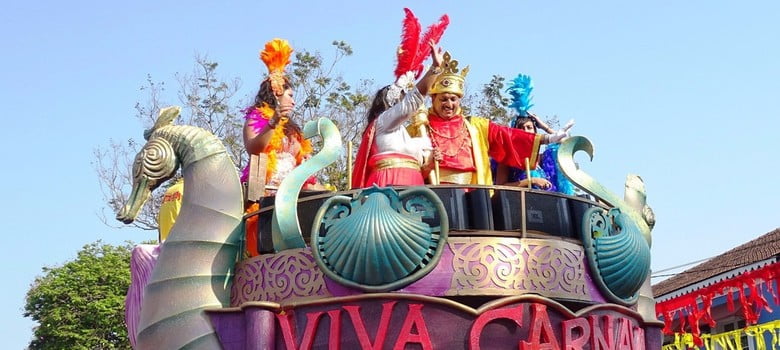Earlier this week, residents of Panaji, Goa’s capital, awoke to the sight of large pink masks and blue, red and green buntings being draped on the street along the Mandovi River, where a sprinkling of brown-headed gulls enjoyed the early February sun.
This weekend, Carnival ‒ the burst of celebration before Christians begin to observe the 40-day period of abstinence ‒ is being held across the state. The advance preparations for the four-day festival came as a surprise for residents, who are more used to seeing white-cloth barricades being hastily erected at one end of the street even as the parade is about to begin at the other.
From February 6-9, with the backing of the state government, the streets in Panaji, Margao, Vasco and Mapusa will be awash with colour, parades and floats. King Momo – the mythical king of the Carnival – and his entourage will take over the state and there will be music, rejoicing and much revelry.
Or that’s the story we tell to bring in the tourists.
How Goa does it
In times bygone, revellers dressed up in colourful home-made costumes would go around the main Carnival areas singing and dancing. Mock fights would take place between groups of boys, employing rotten eggs and tomatoes as the weapons. “Cocotes” or bombs made with paper and filled with clay, were used during these pretend battles.
These days, the boys on foot have been replaced by groups of entertainers on floats decorated with larger-than-life papier-mache depictions of flora, fauna, events of local interest and other newsworthy items. In recent years, floats have themes portraying the 26/11 Mumbai terror attacks, global warming, the disappearing tigers, and local crafts.
This year, the iconic coconut palm is likely to take centre stage after the state government last month controversially decided that it wasn’t a tree after all, and didn’t deserve the conservation protections afforded to other foliage.
The long line of floats is undoubtedly the star attraction of the parade. The vehicles will carry massive speakers that will echo live and recorded music for the entertainment of the thousands who gather to watch the spectacle. Those close to the action will need to keep earplugs handy.
This year, in a bid to improve the quality of the parade, the state government has providedfinancial assistance of Rs 1 lakh to “selected floats” as part of a collaborative project with organisations from the UK and South Africa.
The Goa government has also added a dress code to “curb obscenity” at the parade, but the exact restrictions remain unclear. Does this mean that King Momo (or Queen Momo, as in Margao) and his bevy of ladies will not show a shoulder or a hint of a leg? Or perhaps the dancers in their Kunbi saris will wear longer blouses to hide their bellies?
The government’s moral scruples are likely to be the cause for disappointment for the thousands of tourists from all over the country who throng the streets. For many, this is as close as they will get to the samba drums of Brazil, where the festival is celebrated on a much larger scale. But dress code or not, anyone expecting to see dancers in feathers and little else is living in a fantasy world: the Goa Carnival has always been far more demure.
Some visitors familiar with other Carnival parades around the world come dressed for the occasion with masks and hats, costumes and high heels. They stand out among the “I love Goa” T-shirts and young Indian women in tiny shorts with hands full of wedding henna and red, just-married bangles. Vendors will attempt to make a quick buck selling them masks and noisemakers.
Preparing for chaos
Long-time Carnival watchers know that despite the careful preparations of the authorities, the event will probably follow the traditional routine. For instance, even though white-cloth barricades have been constructed to regulate the flow of people, the enterprising audience can be expected to climb over the piles of uncleared garbage and squeeze through the gaps. They will find a tear in the cloth and make it larger. No matter how tightly the fabric is tied, it is no match for the strength of a thousand grasping hands.
For many local residents, the barricade and the crowds are an effective deterrent. It’s much more relaxing to watch the parade on live television, with close-ups of the action and tea and friends for company.
By early in the evening, chaos will reign. Motorcycles and cars will clog every surface available, including pavements and zones that have been cordoned off. Eventually, the police will give up and the traffic will sputter and freeze like a mythical beast with a life of its own.
By sundown, as the parade has ended and the tourists are wandering off, residents will heave a sigh of relief. The familiar mound of trash near Panjim’s new Patto Bridge will have doubled in size. There will be plastic bags and bottles on the river bank and in the water.
The gulls will not come back at night. And, if they’re wise, neither will the tourists.
[“source-scroll”]






 Photo Credit:
Photo Credit: